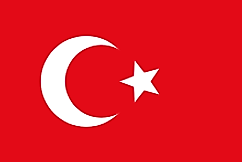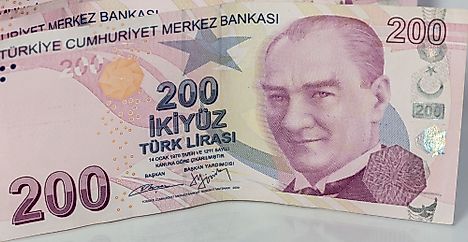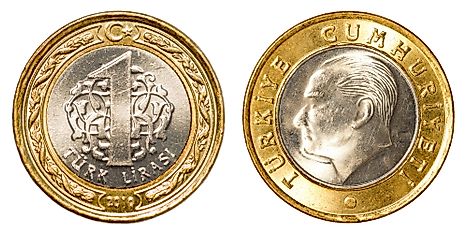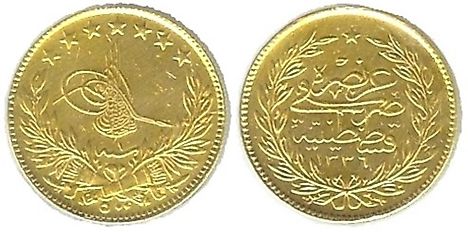Flags, Symbols & Currency of Turkey
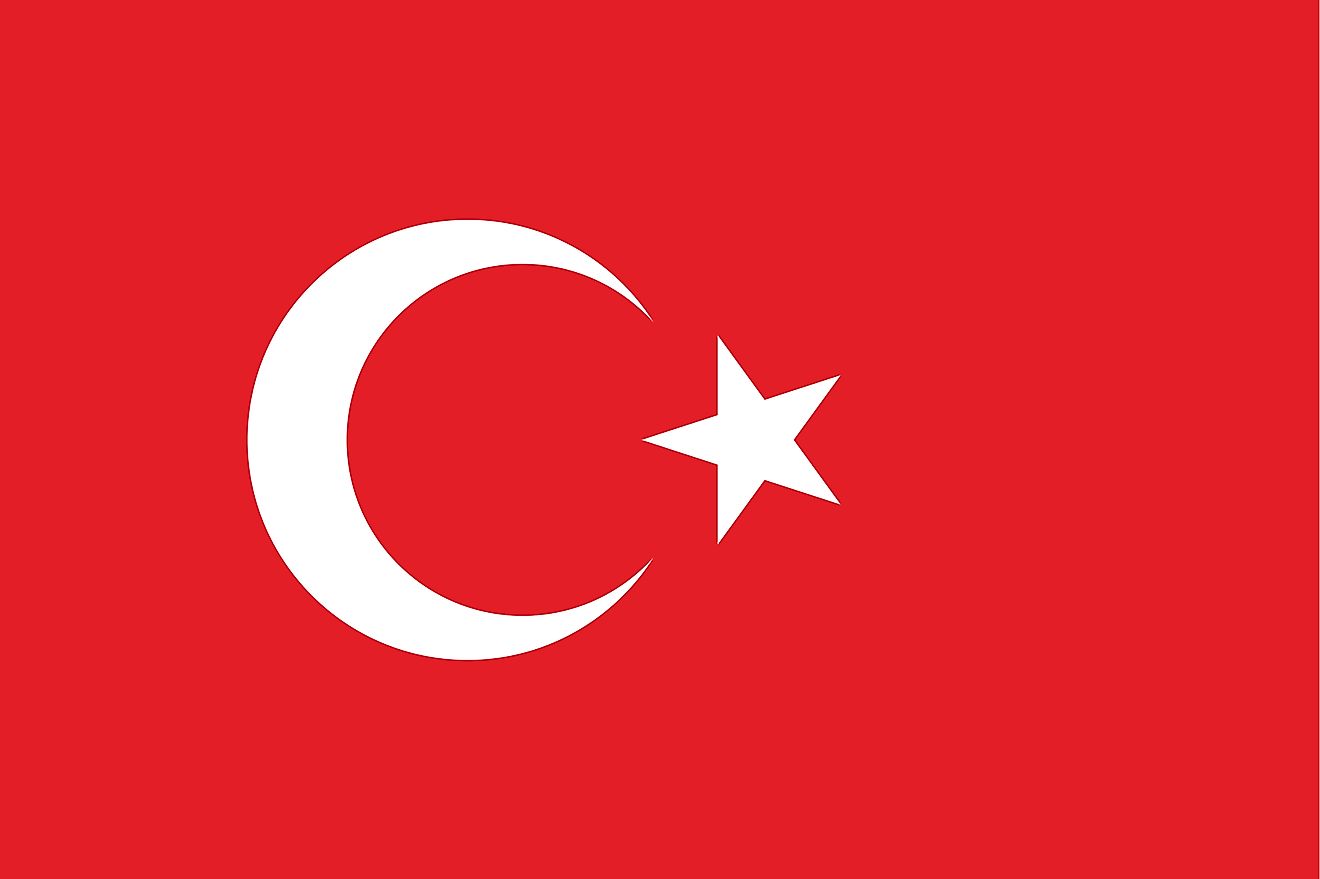
The National Flag of Turkey was officially adopted on June 5, 1936.
The National Flag of Turkey features a red background with a vertical white crescent moon (the closed portion of which is towards the hoist side) and a white five-pointed star centered just outside the crescent opening; both of which are placed slightly to the left on the red background. The red color was adopted from the imperial standard color of the banner of the Ottoman Empire in the 17th century. The red background of the Turkish flag represents the bloodshed by soldiers who lost their lives during Turkey’s War of Independence against the colonial powers of France, England, Greece, and Russia. The flag represents the reflection of the moon and a star in a pool of blood of Turkish warriors. The crescent moon and star serve as insignia for Turkic peoples. The crescent is used in honor of the religious affiliations of the nation and its people, while the white star represents the diversity of Turkish cultures. The flag has a width-to-length proportion ratio of 2:3.
History of the Flag of Turkey
The history behind the Turkish flag is based on various theories. The oldest theory is linked to the first Ottoman Emperor, Osman I, who reported seeing a crescent moon appear from the chest of a Sharia judge, whose daughter he pursued a hand in marriage, before exploding. The explosion was construed as the dynasty of Constantinople (Istanbul). The most popular theory is associated with the Battle of Kosovo, which led to the establishment of the Ottoman Empire which ruled until the 19th century. The image is believed to be a part of this historic event that established Turkey after the end of the Ottoman rule. The history of the flag dates back to the Ottoman era and includes several flags that incorporate the crescent and star. The crescent and star on a red field were popular during the Ottoman Empire and was introduced in 1844. The traditional star had eight points which represented each of the eight states of the empire. In 1923, after the declaration of the Republic of Turkey, this old flag from the Ottoman Empire was used. The flag has been modified occasionally, the most recent being a reduction in the number of star points from eight to five in 1936.
Symbols of Turkey
The National Coat of Arms of Turkey

The National Coat of Arms/Emblem of Turkey contains the crescent and star symbols of Islam in red and is an adaptation of the national flag.
National Anthem
- Anthem Title: "İstiklal Marşı" ("Independence March")
- Music Composer: Osman Zeki Ungor (composer) and Edgar Manas (orchestration)
- Lyricist: Mehmet Akif Ersoy
- Date of Adoption: March 12, 1921
"İstiklal Marşı" ("Independence March") is the national anthem of Turkey. The music of the anthem have been composed by Osman Zeki Ungor. The anthem was orchestrated by Edgar Manas. The lyrics of the anthem have been authored by Mehmet Akif Ersoy. The anthem was officially adopted as the national anthem on March 12, 1921. Of the total 10-stanza anthem, only the first two stanzas are usually sung.
"İstiklal Marşı" (Turkish)
1.
Korkma! Sönmez bu şafaklarda yüzen al sancak,
Sönmeden yurdumun üstünde tüten en son ocak.
O benim milletimin yıldızıdır, parlayacak;
O benimdir, o benim milletimindir ancak.
2.
Çatma, kurban olayım, çehreni ey nazlı hilal!
Kahraman ırkıma bir gül; ne bu şiddet, bu celal?
Sana olmaz dökülen kanlarımız sonra helal...
Hakkıdır, Hakk’a tapan milletimin istiklal.
3.
Ben ezelden beridir hür yaşadım, hür yaşarım,
Hangi çılgın bana zincir vuracakmış? Şaşarım.
Kükremiş sel gibiyim, bendimi çiğner, aşarım,
Yırtarım dağları, enginlere sığmam, taşarım.
4.
Garbın afakını sarmışsa çelik zırhlı duvar,
Benim iman dolu göğsüm gibi serhaddim var.
Ulusun, korkma! Nasıl böyle bir imanı boğar,
“Medeniyet” dediğin tek dişi kalmış canavar?
5.
Arkadaş! Yurduma alçakları uğratma sakın,
Siper et gövdeni, dursun bu hayâsızca akın.
Doğacaktır sana vadettiği günler Hakk’ın,
Kim bilir, belki yarın belki yarından da yakın.
6.
Bastığın yerleri “toprak” diyerek geçme, tanı,
Düşün altındaki binlerce kefensiz yatanı.
Sen şehit oğlusun, incitme, yazıktır atanı,
Verme, dünyaları alsan da bu cennet vatanı.
7.
Kim bu cennet vatanın uğruna olmaz ki feda?
Şüheda fışkıracak, toprağı sıksan şüheda.
Canı, cananı, bütün varımı alsın da Hüda,
Etmesin tek vatanımdan beni dünyada cüda.
8.
Ruhumun senden İlahî, şudur ancak emeli:
Değmesin mabedimin göğsüne namahrem eli.
Bu ezanlar, ki şehadetleri dinin temeli,
Ebedî, yurdumun üstünde benim inlemeli.
9.
O zaman vecdile bin secde eder, varsa taşım,
Her cerihamdan, İlahî, boşanıp kanlı yaşım,
Fışkırır ruhumücerret gibi yerden naaşım,
O zaman yükselerek arşa değer belki başım.
10.
Dalgalan sen de şafaklar gibi ey şanlı hilal!
Olsun artık dökülen kanlarımın hepsi helal.
Ebediyen sana yok, ırkıma yok izmihlal.
Hakkıdır, hür yaşamış bayrağımın hürriyet;
Hakkıdır, Hakk’a tapan milletimin istiklal.
"Independence March"
1.
Fear not; For the crimson banner that proudly ripples in this glorious dawn, shall not fade,
Before the last fiery hearth that is ablaze within my homeland is extinguished.
For that is the star of my people, and it will forever shine;
It is mine; and solely belongs to my valiant nation.
2.
Frown not, I beseech you, oh thou coy crescent!.
Smile upon my heroic nation! Why the anger, why the rage?
Our blood which we shed for you shall not be worthy otherwise;
For freedom is the absolute right of my God-worshipping nation!
3.
I have been free since the beginning and forever shall be so.
What madman shall put me in chains! I defy the very idea!
I'm like the roaring flood; trampling my banks and overcoming my body,
I'll tear apart mountains, exceed the Expanses and still gush out!
4.
The horizons of the West may be bound with walls of steel,
But my borders are guarded by the mighty bosom of a believer
Let it howl!, Do not be afraid! And think: how can this fiery faith ever be extinguished,
By that battered, single-fanged monster you call "civilization"?
5.
My friend! Leave not my homeland to the hands of villainous men!
Render your chest as armour and your body as bulwark! Halt this disgraceful assault!
For soon shall come the joyous days of divine promise;
Who knows? Perhaps tomorrow? Perhaps even sooner!
6.
View not the soil you tread on as mere earth - recognize it!
And think about the shroudless thousands who lie so nobly beneath you.
You're the glorious son of a martyr - take shame, grieve not your ancestors!
Unhand not, even when you're promised worlds, this heavenly homeland.
7.
Who would not sacrifice their life for this paradise of a country?
Martyrs would burst forth should one simply squeeze the soil! Martyrs!
May God take my life, my loved ones, and all possessions from me if He will,
But let Him not deprive me of my one true homeland in the world.
8.
Oh glorious God, the sole wish of my pain-stricken heart is that,
No heathen's hand should ever touch the bosom of my sacred Temples.
These adhans and their testimonies are the foundations of my religion,
And may their noble sound prevail thunderously across my eternal homeland.
9.
For only then, shall my fatigued tombstone, if there is one, prostrate, a thousand times in ecstasy,
And tears of blood shall, oh Lord, spill out from my every wound,
And my lifeless body shall burst forth from the earth like an eternal spirit,
Perhaps only then, shall I peacefully ascend and at long last reach the heavens.
10.
So ripple and wave like the bright dawning sky, oh thou glorious crescent,
So that our every last drop of blood may finally be blessed and worthy!
Neither you nor my kin shall ever be extinguished!
For freedom is the absolute right of my ever-free flag;
For independence is the absolute right of my God-worshipping nation!
The Currency of Turkey is the Turkish lira
The current official currency of Turkey is the Turkish lira (₺, TRY, TL). It is subdivided into 100 kurus. The rate of inflation in Turkey is high compared to other developed countries, hence the fluctuating exchange rate of the lira. Turkey is one of the founding members of the Organization of Economic Co-operation and Development (OECD), aimed at improving the economic and social conditions of people around the world.
Coins
The current Turkish lira coins in circulation were minted and issued in 2009 in denominations of 1 lira and 1, 5, 10, 25, and 50 kuruş.
The first Turkish lira coins were introduced in 1923, which included Arabic inscriptions and were made primarily of aluminum–bronze. The second Turkish lira coins were issued during the 2005 transition, with coins bearing the portrait of Mustafa Kemal Atatürk. Denominations of the 50 new kuru and the 1 new lira minted in 2005 were somehow similar to the Eurozone’s €1 and €2, which resulted in the reversing of the rings in the subsequent 2009 issue.
Banknotes
Current Turkish lira banknotes are referred to as the E-9 Emission Group and were introduced in January 2009 by the Central Bank, which mints and distributes the currency. The notes are minted and distributed in denominations of 5, 10, 20, 50, 100, and 200 lira. Banknotes are made in different sizes and colors to reduce forgery incidents. The major specificity of the new banknotes is that each denomination represents a celebrated Turkish personality, rather than the geographical sites and architectural features of Turkey.
Historical currencies of Turkey
The first version of the lira, known as the Ottoman lira, along with related currencies in the Middle East and Europe, had its roots in the ancient Roman weight unit known as the libra, which referred to the Troy pound of silver. During medieval times, the use of libra spread out through the Republic of Turkey. The Ottoman lira became the official currency in 1844, replacing the kurus that was in circulation during that time.
There have been two versions of the Turkish lira. The first Turkish lira was introduced in 1923 through an official gazette that was later canceled by the Democratic Party after World War II. The change was implemented through a second, third, and fourth issue, having portraits of İsmet İnönü. The Turkish lira has been listed twice in the Guinness Book of Records (1995-1996 and 1999-2004) as the world’s most devalued currency. The currency had lost its value to the extent that one gold lira coin could be sold for 154,400,000 TL before the 2005 re-evaluation.
The second Turkish lira was introduced in 2005 when the Grand National Assembly of Turkey approved a law that required the exclusion of the six zeros from the Turkish lira. The government introduced banknotes and coins bearing the portraits of Mustafa Kemal Atatürk, the first president of Turkey, on the obverse of banknotes and the reverse side of coins.
